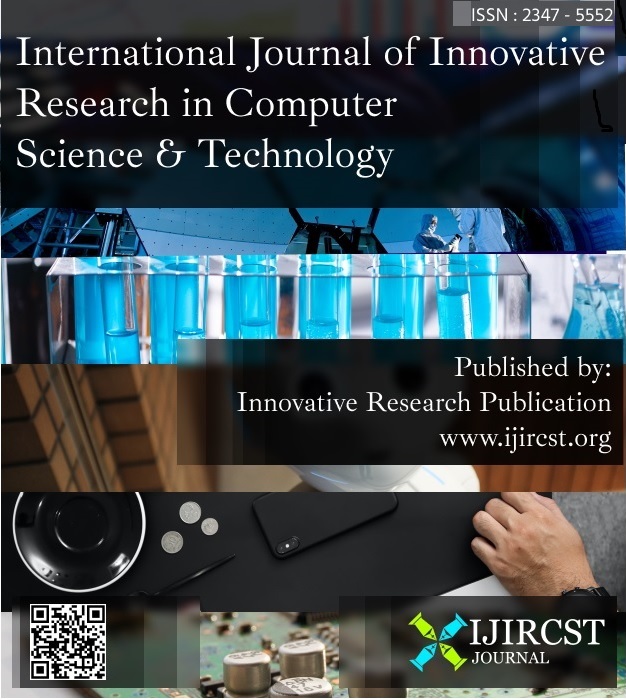Detecting Intended Target Birds and Using Frightened Techniques in Crops to Preserve Yield
Keywords:
AI, IoT, YOLO, Blynk Server, CNNAbstract
An invention that is more appealing and practical for the general public is required as the world moves toward new trends and technology. The study uses AI and IoT technology to reduce crop damage caused by birds, a significant threat to crops. The automated system identifies and discourages specific bird species, reducing the cost of traditional deterrents. The system uses YOLO, a high-performance object detection model, to identify birds in real-time using a webcam feed. It then uses a ResNet100-based CNN for selective bird classification, minimizing disruption to wildlife. The system identifies a bird and triggers automated responses, providing real-time notifications via the Blynk platform. A buzzer on an ESP32 board scares birds, protecting crops. The ESP32 board manages the buzzer and communication with the Blynk server. The Paper utilizes AI and IoT to automate bird detection and deterrence, reducing human intervention and providing a cost-effective solution for farmers.
References
J. Redmon and A. Farhadi, "YOLOv3: An Incremental Improvement," arXiv preprint, arXiv:1804.02767, 2018. Available from: https://arxiv.org/abs/1804.02767
K. He, X. Zhang, S. Ren, and J. Sun, "Deep Residual Learning for Image Recognition," in Proc. IEEE Conf. Comput. Vis. Pattern Recognit., pp. 770-778, 2016. Available from: https://openaccess.thecvf.com/content_cvpr_2016/papers/He_Deep_Residual_Learning_CVPR_2016_paper.pdf
Anand S. and Radhakrishna S., "Investigating trends in human-wildlife conflict: is conflict escalation real or imagined?," Journal of Asia-Pacific Biodiversity, vol. 10, no. 2, pp. 154-161, 2017. Available from: http://dx.doi.org/10.1016/j.japb.2017.02.003
A. Bouet, A. Boka, and N. Kouassi, "Impact de la surveillance humaine sur les dégâts d’oiseaux en riziculture pluviale," Int. J. Biol. Chem. Sci., vol. 8, no. 5, pp. 1825-1834, 2014. Available from: http://dx.doi.org/10.4314/ijbcs.v8i5.33
Z. Wang, A. S. Griffin, A. Lucas, and K. C. Wong, "Psychological warfare in vineyard: Using drones and bird psychology to control bird damage to wine grapes," Crop Protection, vol. 120, pp. 163-170, 2019. Available from: https://doi.org/10.1016/j.cropro.2019.02.025
N. A. Firdaus, “Sound Tracking Tool on Bird Pest Repellent System Using ARM STM32F4,” Institut Teknologi Sepuluh Nopember, 2015.
R. Yoshihashi, R. Kawakami, M. Iida, and T. Naemura, "Evaluation of bird detection using time-lapse images around a wind farm," in European Wind Energy Association Conference, Nov. 2015. Available from: https://open-vision.sc.e.titech.ac.jp/~reikawa/publication/yoshihashi-ewea2015.pdf
R. E. Harris and R. A. Davis, "Evaluation of the efficacy of products and techniques for airport bird control," 1998. Available from: https://tc.canada.ca/en/aviation/publications/evaluation-efficacy-products-techniques-airport-bird-control-03-1998-tp-13029
B. J. Zur, "Bird Strike Study," Air Transport World, 1982. Available from: https://tc.canada.ca/en/aviation/publications/evaluation-efficacy-products-techniques-airport-bird-control-03-1998-tp-13029/
EIFAC—European Inland Fisheries Advisory Commission, "Working Party on Prevention and Control of Bird Predation in Aquaculture and Fisheries Operations," 1988. Available from: https://www.fao.org/fishery/docs/CDrom/aquaculture/a0844t/docrep/009/T0054E/T0054E00.htm
R. D. Thompson, B. E. Johns, and C. V. Grant, "Cardiac and Operant Behavior Response of Starlings (Sturnus Vulgaris) to Distress and Alarm Sounds," in Proc. Bird Control Seminar, 1979, pp. 119–124. Available from: https://digitalcommons.unl.edu/cgi/viewcontent.cgi?article=1016&context=icwdmbirdcontrol
E. Harris, E. P. de Crom, J. Fouche, and A. Wilson, "Comparative study on the short-term effects of audio and visual raptor presence on a pigeon population, with a view towards pest control," Int. J. Pest Manage., vol. 66, no. 1, pp. 31-39, 2020. Available from: https://doi.org/10.1080/09670874.2018.1542185
W. F. Laurance, D. Carolina Useche, J. Rendeiro, M. Kalka, C. J. Bradshaw, S. P. Sloan, and W. Scott McGraw, "Averting biodiversity collapse in tropical forest protected areas," Nature, vol. 489, no. 7415, pp. 290-294, 2012. Available from: https://doi.org/10.1038/nature11318
C. E. Knittle, J. L. Cummings, G. M. Linz, and J. F. Besser, "An Evaluation of Modified 4-Aminopyridine Baits for Protecting Sunflower from Blackbird Damage," in Proc. Vertebrate Pest Conference 13, 1988, pp. 248–253. Available from: https://agris.fao.org/agris-search/search.do?recordID=US8924811
R. A. Dolbeer, J. L. Belant, and L. Clark, "Methyl Anthranilate Formulations to Repel Birds from Water at Airports and Food at Landfills," in Proc. Great Plains Wildlife Damage Control Conference 11, 1993, pp. 42–53. Available from: https://digitalcommons.unl.edu/cgi/viewcontent.cgi?article=1328&context=gpwdcwp
R. Beason, "What Can Birds Hear?," USDA Natl. Wildl. Res. Cent. Staff Publ., vol. 21, 2004. Available from: https://escholarship.org/uc/item/1kp2r437
S. A. V. Bael, S. M. Philpott, R. Greenberg, P. Bichier, N. A. Barber, K. A. Mooney, et al., "Birds as predators in tropical agroforestry systems," Ecology, vol. 89, no. 4, pp. 928–934, 2008. Available from: https://doi.org/10.1890/06-1976.1
L. M. Lute, D. C. Navarrete, P. M. Nelson, and L. M. Gore, "Moral dimensions of human–wildlife conflict," Conserv. Biol., vol. 30, no. 6, pp. 1200–1211, 2016. Available from: https://doi.org/10.1111/cobi.12731
A. Benítez-López, R. Alkemade, A. Schipper, D. Ingram, P. Verweij, J. Eikelboom, et al., "The impact of hunting on tropical mammal and bird populations," Science, vol. 356, no. 6334, pp. 180–183, 2017. Available from: https://doi.org/10.1126/science.aaj1891




